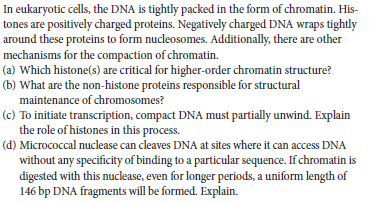In eukaryotic cells, the DNA is tightly packed in the form of chromatin. His- tones are positively charged proteins. Negatively charged DNA wraps tightly around these proteins to form nucleosomes. Additionally, there are other mechanisms for the compaction of chromatin. (a) Which histone(s) are critical for higher-order chromatin structure? (b) What are the non-histone proteins responsible for structural maintenance of chromosomes? (c) To initiate transcription, compact DNA must partially unwind. Explain the role of histones in this process. (d) Micrococcal nuclease can cleaves DNA at sites where it can access DNA without any specificity of binding to a particular sequence. If chromatin is digested with this nuclease, even for longer periods, a uniform length of 146 bp DNA fragments will be formed. Explain.
In eukaryotic cells, the DNA is tightly packed in the form of chromatin. His- tones are positively charged proteins. Negatively charged DNA wraps tightly around these proteins to form nucleosomes. Additionally, there are other mechanisms for the compaction of chromatin. (a) Which histone(s) are critical for higher-order chromatin structure? (b) What are the non-histone proteins responsible for structural maintenance of chromosomes? (c) To initiate transcription, compact DNA must partially unwind. Explain the role of histones in this process. (d) Micrococcal nuclease can cleaves DNA at sites where it can access DNA without any specificity of binding to a particular sequence. If chromatin is digested with this nuclease, even for longer periods, a uniform length of 146 bp DNA fragments will be formed. Explain.
Biochemistry
9th Edition
ISBN:9781319114671
Author:Lubert Stryer, Jeremy M. Berg, John L. Tymoczko, Gregory J. Gatto Jr.
Publisher:Lubert Stryer, Jeremy M. Berg, John L. Tymoczko, Gregory J. Gatto Jr.
Chapter1: Biochemistry: An Evolving Science
Section: Chapter Questions
Problem 1P
Related questions
Question

Transcribed Image Text:In eukaryotic cells, the DNA is tightly packed in the form of chromatin. His-
tones are positively charged proteins. Negatively charged DNA wraps tightly
around these proteins to form nucleosomes. Additionally, there are other
mechanisms for the compaction of chromatin.
(a) Which histone(s) are critical for higher-order chromatin structure?
(b) What are the non-histone proteins responsible for structural
maintenance of chromosomes?
(c) To initiate transcription, compact DNA must partially unwind. Explain
the role of histones in this process.
(d) Micrococcal nuclease can cleaves DNA at sites where it can access DNA
without any specificity of binding to a particular sequence. If chromatin is
digested with this nuclease, even for longer periods, a uniform length of
146 bp DNA fragments will be formed. Explain.
Expert Solution
This question has been solved!
Explore an expertly crafted, step-by-step solution for a thorough understanding of key concepts.
Step by step
Solved in 3 steps

Recommended textbooks for you

Biochemistry
Biochemistry
ISBN:
9781319114671
Author:
Lubert Stryer, Jeremy M. Berg, John L. Tymoczko, Gregory J. Gatto Jr.
Publisher:
W. H. Freeman

Lehninger Principles of Biochemistry
Biochemistry
ISBN:
9781464126116
Author:
David L. Nelson, Michael M. Cox
Publisher:
W. H. Freeman

Fundamentals of Biochemistry: Life at the Molecul…
Biochemistry
ISBN:
9781118918401
Author:
Donald Voet, Judith G. Voet, Charlotte W. Pratt
Publisher:
WILEY

Biochemistry
Biochemistry
ISBN:
9781319114671
Author:
Lubert Stryer, Jeremy M. Berg, John L. Tymoczko, Gregory J. Gatto Jr.
Publisher:
W. H. Freeman

Lehninger Principles of Biochemistry
Biochemistry
ISBN:
9781464126116
Author:
David L. Nelson, Michael M. Cox
Publisher:
W. H. Freeman

Fundamentals of Biochemistry: Life at the Molecul…
Biochemistry
ISBN:
9781118918401
Author:
Donald Voet, Judith G. Voet, Charlotte W. Pratt
Publisher:
WILEY

Biochemistry
Biochemistry
ISBN:
9781305961135
Author:
Mary K. Campbell, Shawn O. Farrell, Owen M. McDougal
Publisher:
Cengage Learning

Biochemistry
Biochemistry
ISBN:
9781305577206
Author:
Reginald H. Garrett, Charles M. Grisham
Publisher:
Cengage Learning

Fundamentals of General, Organic, and Biological …
Biochemistry
ISBN:
9780134015187
Author:
John E. McMurry, David S. Ballantine, Carl A. Hoeger, Virginia E. Peterson
Publisher:
PEARSON